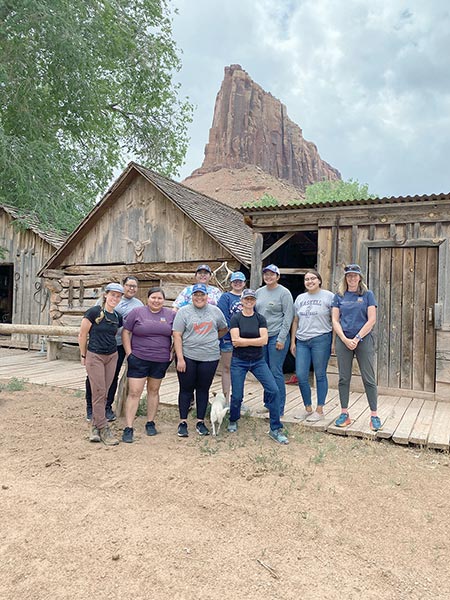
Youth choose summer Nature Conservancy internship
GALLUP

Courtesy photo | Nature Conservancy
The Nature Conservancy’s Canyonlands Research Center, near Moab, Utah, hosted six Indigenous undergraduates as interns. They are shown with their mentors.
The Nature Conservancy’s Canyonlands Research Center near Moab, Utah, hosted six Indigenous undergraduates this summer with hopes of inspiring them to find careers in conservation.
Amber Archie, 21, and Nichole Butler, 22, spent the summer at the center.
Archie is a Diné student at Northern Arizona University and is from Piñon, Arizona. Butler is a Diné student at Utah State University in Blanding and is from Chinchilbeto, Arizona.
They learned a vast amount of information over the seven-week internship.
The information included Indigenous and sustainable agriculture, permaculture, geographical information systems, animal science and droughts.
“Over the course of the seven weeks we learned different things from agriculture to permaculture,” Butler said. “We also got to do a lot of field work because we couldn’t do hands-on work for some of us.”
The students also got to relearn some of the things they learned in university, Butler said.
Since the internship worked with Indigenous youth, Indigenous methods for land and water conservation were taught and exchanged.
Indigenous practices
“I think (using Indigenous practices as a form of land conservation) particularly important because there’s a lot of knowledge that we can gain from Indigenous knowledge since we have been living here since time immemorial,” Archie said.
“It’s just really important that we get our perspective on how to better handle environmental management,” she said.
Archie believes Indigenous knowledge has been collected through many generations and, because of this, there is a lot to share.
Butler stressed the importance of conservation because of the many plants that have gone endangered or are currently near endangerment.
“There are so many uses that we have for them (plants) as Indigenous people,” Butler said. “There are also so many reasons behind why we use them.”
She spoke about climate change and said it would be nice to see a lot of plants growing and flourishing how it was, “way back then.”
The internship gave the students tools to better assess the situation that the Earth is currently in, such as climate change, Archie said.
“Just coming together with Indigenous knowledge, traditionally ecological knowledge and using that to not only better ourselves but the environment as well,” Archie said.
Over the summer, the students also came up with a final research project about ethnobody restoration and conservation.
Final projects
“We just feel that it’s really important, especially pertaining to medicinal herbs used by not only the Navajo but as well as neighboring tribes and other tribes on the other side of the nation,” Archie said. “We just feel that it’s really important to educate and bring awareness to a lot of these various research.”
Butler said she focused on Navajo medicinal plants and how we can start conserving them.
She chose this project because of her great grandmother. She sat down with her and spoke to her about climate change and how it has been impacting her.
“Over the course of the years, we’ve noticed that there has been an increase for use of medicinal herbs because it has been helping us in many ways like for food and medicinal use and also ceremonial use,” Butler said.
She wanted to find a solution because within her community of Chilchinbeto, there is barely any medicinal herbs in the area and she wanted to figure out a way to help them not have to travel to far places to find the herbs.
“One of the solutions that I found was permaculture,” Butler said. “So that’s what I really wanted to start and acknowledge and bring up to my community and also get the youth involved by helping them build that permaculture garden.”
She also had the idea to begin gray water restoration and how her community can build a capture to gather the rainwater that we have been having since the monsoon season started.
“I think that would be a big project for my community and I think that would be a great solution for right now,” Butler said.








 Highway 264,
Highway 264, I-40, WB @ Winslow
I-40, WB @ Winslow